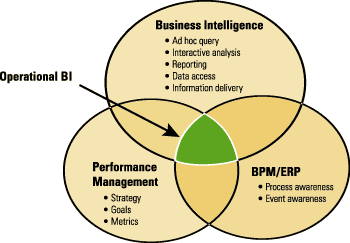LESSON - Aligning Business Intelligence with Business Process
By Darren Cunningham, Product Marketing Director, Business Objects
With mounting compliance and security pressures and increasing demands for up-to-the-second information access, the need for optimized and transparent business processes has never been more apparent. Operational BI builds on existing technology standards to make business intelligence more flexible, transparent, and cost-effective by tightly integrating business intelligence (BI) with your organization’s constantly evolving business processes. Making BI more process-aware and real-time-enabled results in process optimization, better visibility into daily operations, and a faster and higher overall return on investment and information.
What does it mean for BI to be tightly linked to business process? Let’s look at an example. An insurance underwriter needs to provide quotes to customers quickly in order to maximize customer satisfaction and minimize risk. To be operationally aligned, integrated, and aware, BI must be embeddable within the process to perform risk analysis. BI must allow a user to analyze the process itself to help understand real-time and historical performance. And BI must enable users to define and share best practices for the underwriting process. In the case of the insurance underwriter, BI is clearly a part of the business process—checking credit scores, analyzing risk, and analyzing overall customer value—as well as above the process, looking for bottlenecks and driving real-time adjustments if processing falls behind.

Illustration 1. Operational BI is business intelligence that is more tightly linked with business operations, the people involved, and the way they work.
The Evolution of Operational BI
BI has evolved from solely focusing on data access to focusing more on the people who rely on that data and the decisions they make with it. BI has evolved from solving only IT-centric reporting challenges (by being embedded into application development environments), to becoming truly information-consumer focused (by delivering personalized dashboards, scorecards, and alerts).
Operational BI can broaden and extend traditional approaches to information delivery and align the overall strategy with typically small, but continuous and repeatable, business processes and decisions made by individuals and groups throughout the day.
- Operational BI builds on core BI capabilities to access real-time data sources and provide useful reports and analysis.
- Operational BI leverages performance management capabilities for defining and understanding organizational strategy, goals, and metrics.
- Operational BI builds on an understanding of the day-to-day business processes defined and managed within ERP/BPM systems.
The Impact of Operational BI
Operational BI ensures that trusted and timely information is accessible to more people inside and outside the organization. This information is delivered through embedded analytics, process analysis, and repeatable, decision-centric business processes.
- Embedded analytics brings BI closer to where tactical decisions are made through built-in Web services and a service-oriented architecture (SOA).
- The ability to link performance management initiatives with existing processes allows individuals and organizations to track, monitor, and analyze processes and measure their impact on day-to-day operations.
- By establishing repeatable BI best practices, it becomes possible for individuals and groups to be guided through decision-centric business processes.
- The ability to identify operational inefficiencies and set performance goals and alerts that combine business and process data gives executives and line-of-business managers insight into up-to-the-minute business changes.
- A visual interface assigns accountable owners for each milestone and tracks ongoing progress. This supports collaborative decision making and provides an audit trail suitable for compliance management.
With the right strategy for operational BI, you can think about your BI and performance management initiatives from a process-centric perspective instead of taking only a data-centric view. Operational BI is the vehicle to unify tactical and strategic BI initiatives, link BI to business processes, and make trusted information more useful and available to more users in your organization.
This article originally appeared in the issue of .